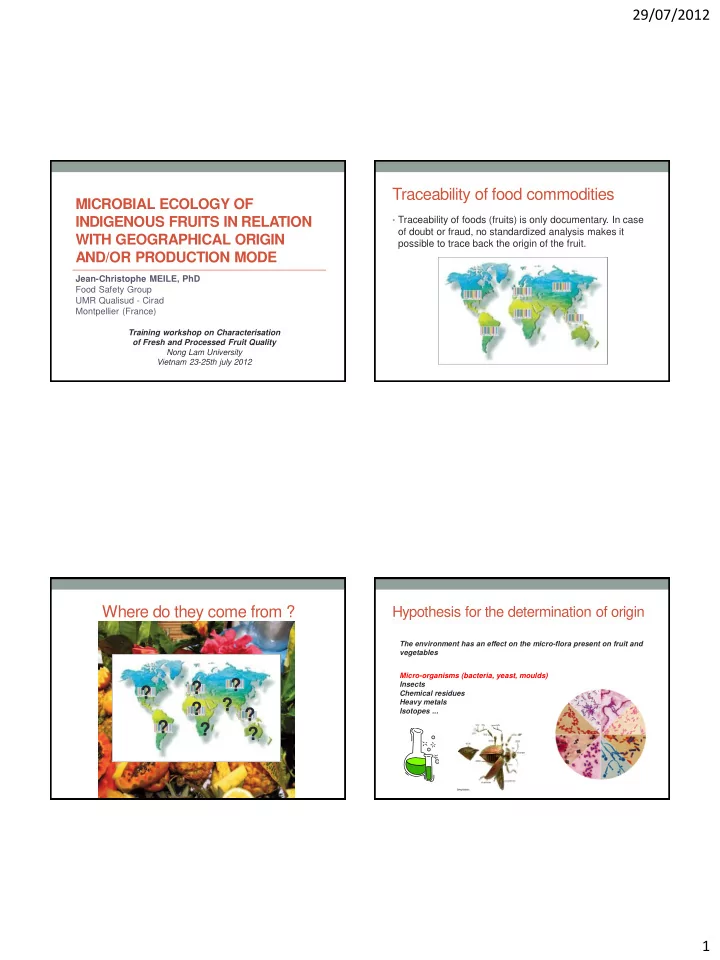

29/07/2012 Traceability of food commodities MICROBIAL ECOLOGY OF INDIGENOUS FRUITS IN RELATION • Traceability of foods (fruits) is only documentary. In case of doubt or fraud, no standardized analysis makes it WITH GEOGRAPHICAL ORIGIN possible to trace back the origin of the fruit. AND/OR PRODUCTION MODE Jean-Christophe MEILE, PhD Food Safety Group UMR Qualisud - Cirad Montpellier (France) Training workshop on Characterisation of Fresh and Processed Fruit Quality Nong Lam University Vietnam 23-25th july 2012 Where do they come from ? Hypothesis for the determination of origin The environment has an effect on the micro-flora present on fruit and vegetables Micro-organisms (bacteria, yeast, moulds) ? ? Insects ? Chemical residues ? Heavy metals ? ? Isotopes ... ? ? ? 1
29/07/2012 Analyses in Food Microbial Ecology … Global Microbial Ecology Analysis What for ? using PCR-DGGE technique DNA extraction PCR Amplification DGGE Separation Food Safety : Inventory of microbial species associated with food products (contaminants, pathogens) Food Process/Transformation : Monitoring of the microflora dynamics (identification of dominant, fermentation flora, etc …) Food quality determinants (measurable and/or controlled parameters such as pH, Aw, Temperature, Biological activity, toxin levels, Organoleptical compounds, Micronutrients …) Target DNA (16S, 26S, 28S) Traceability : Microbial Ecology linked to geographical origin and/or production mode of foodstuff Analysis of food microbial ecology DGGE principle at the molecular level (PCR-DGGE) Double strand DNA of the same size from PCR • Provides a global snapshot of the microbial flora structure DNA with lower Least concentrated in denaturing GC-content agents • Culture-independant (no microbe cultivation or isolation) One band = one species or Linear gradient of • Analyses on total DNA directly extracted from foods phylotype denaturings agents • rDNA DGGE profiles : Food Biological Barcodes DNA with higher Most concentrated in denaturing generated by Genetic Fingerprints dependant on the GC-content agents structure of the microbial flora (number et relative abundance of species) 2
29/07/2012 Example : Physalis Applications on various foodstuffs : Yeast DGGE profiles of Physalis from 4 regions of Egypt (El Sheikha et al. 2009) - Fish 1 2 3 4 1 2 3 4 1 2 3 4 1 2 3 4 - Farm Fish from Thaïlande & Vietnam (Ratanaporn Leesing 2005 & Nguyen Doan Duy 2008) Q M B A - Traditional Fermented Fish from Ivory Coast (Clémentine Kouakou 2012) - Fruits - Physalis from Colombia, Uganda & Egypt - Shea tree from Mali, Uganda, Senegal & Cameroon - Clementine Spain & Marocco (Aly El Sheikha 2010) - Mangoes from Pakistan (Meile 2012) - Coffee & Cocoa beans from Mexico, Venezuela, Cameroon and Ivory Coast (Noël Durand et Nadège Nganou 2012) Q: Qalyoubia M: Minufiya B: Beheira A: Alexandria - Sea salt from french and portuguese atlantic solar salterns (Meile 2012) (1,2) Fruits with husk; (3,4) Fruits without husk - Nem Chua (traditional fermented saussage from Vietnam) Image Analysis of DGGE profiles using Example of processed food : Image Quant software Nem Chua (traditional fermented saussage from Vietnam) Fermentation time 0 1 2 3 4 Days Purification Sequencing Identification Bacterial DGGE profile Realized with PHAN THANH TAM School of Biotechnology and Food To be adapted to fermented products Technology, Hanoi University such as wine or vinegar 3
29/07/2012 Comparative analysis of DGGE profiles Few results obtained with fruits From different origins Digitization of the DGGE gel image (Image Quant) Statistical comparison of Biological barcodes (DGGE profiles) allow fruits from different geographical Similarity matrix based on presence/absence origin to be discriminated of co-migrating bands Multifactorial Analysis of data Hypothesis on the biological barcode (PCA & Cluster) • Biological barcode influenced by two main factors : Minufiya Beheira Natural environment Alexandrie (location of production) Qalyoubia Human intervention B4 (agricultural practices) B3 Q4 Q3 M4 M3 A4 A3 80 85 90 95 100 Similarity 4
29/07/2012 Example with Necarine Comparative analysis of production modes • Measure the influence of human practices on food • Statistical analysis (PCA) microbial ecology • Example : organic farming as a model Organic • Discrimination of organic from conventional food products Chemical inputs (fungicides, Organic inputs Herbicides, pesticides, fertilizers ,…) Integrated Conventional Nectarines grown using 3 different types of farming : VS DGGE profiles comparison show that Conventional , Organic and integrated the modes of productions can be discrimnated Same variety and location of production Conclusions EXAMPLE WITH NECARINE Organic Integrated Conventional • Differences between agricultural practices display a 1 2 3 1 2 3 1 2 3 mesurable effect on the global microflora (bacteria, yeast 4 4 4 and moulds) of food products • The geographical origin together with the mode of production provide agricultural products with a unique signature or barcode that can be detected by molecular Nectarines produced with 3 different Types of farming were analysed : microbial ecology appraches (such as PCR-DGGE) Conventional , Organic and integrated • This biological barcode cannot be falsified Same variety and location of production DGGE profiles using yeast 26S rDNA 5
29/07/2012 Perspectives • Identify and determine microbial species that could be used as « markers » of geographical origins and/or the production mode • Strategy for the setup of fast-analysis tools that could be used for authentication and controls along the chain of production and distribution Aknowledgments • Food Safety Group headed by Dr. Didier Montet Ratanaporn LEESING Duy Nguyen Doan Aly El Sheikha Celine Bigot Magali Gies • Staff of UMR Qualisud, Cirad Montpellier 6
Recommend
More recommend